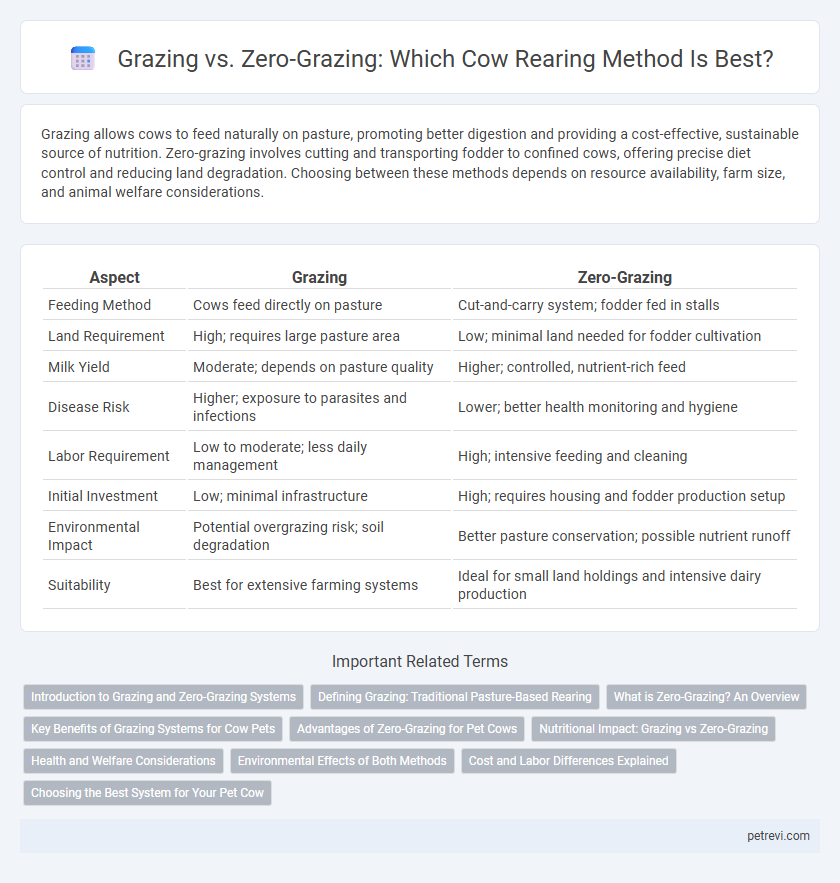Grazing allows cows to feed naturally on pasture, promoting better digestion and providing a cost-effective, sustainable source of nutrition. Zero-grazing involves cutting and transporting fodder to confined cows, offering precise diet control and reducing land degradation. Choosing between these methods depends on resource availability, farm size, and animal welfare considerations.
Table of Comparison
| Aspect | Grazing | Zero-Grazing |
|---|---|---|
| Feeding Method | Cows feed directly on pasture | Cut-and-carry system; fodder fed in stalls |
| Land Requirement | High; requires large pasture area | Low; minimal land needed for fodder cultivation |
| Milk Yield | Moderate; depends on pasture quality | Higher; controlled, nutrient-rich feed |
| Disease Risk | Higher; exposure to parasites and infections | Lower; better health monitoring and hygiene |
| Labor Requirement | Low to moderate; less daily management | High; intensive feeding and cleaning |
| Initial Investment | Low; minimal infrastructure | High; requires housing and fodder production setup |
| Environmental Impact | Potential overgrazing risk; soil degradation | Better pasture conservation; possible nutrient runoff |
| Suitability | Best for extensive farming systems | Ideal for small land holdings and intensive dairy production |
Introduction to Grazing and Zero-Grazing Systems
Grazing systems allow cows to feed directly on pasture, promoting natural behavior and reducing feed costs through access to fresh forage rich in nutrients like fiber and protein. Zero-grazing involves housing cows in enclosures where they are fed cut fodder, enabling precise diet control and minimizing land use, which is beneficial in areas with limited grazing land. Both systems impact milk yield, animal health, and farm sustainability, influencing management decisions based on available resources and environmental conditions.
Defining Grazing: Traditional Pasture-Based Rearing
Grazing refers to the traditional pasture-based rearing method where cows feed directly on natural or cultivated grasses in open fields, promoting natural foraging behavior and nutrient intake. This system supports a diverse diet through access to varied plant species, enhancing milk flavor and animal health. Pasture conditions and seasonal changes significantly influence grazing efficiency and overall productivity in cow rearing.
What is Zero-Grazing? An Overview
Zero-grazing is a cattle rearing method where cows are confined and fed harvested fodder instead of grazing on open pastures. This system improves feed management, reduces land requirements, and allows better control over nutrition and health. Zero-grazing is particularly effective in areas with limited grazing land or during dry seasons when pasture availability is low.
Key Benefits of Grazing Systems for Cow Pets
Grazing systems for cow pets enhance natural foraging behaviors, promoting stronger immune systems and improved digestive health due to access to diverse pasture plants. These systems reduce feed costs significantly by utilizing available land resources while supporting environmental sustainability through better soil management and carbon sequestration. Grazing also increases animal welfare by providing cows with ample space to move freely, resulting in lower stress levels and higher overall productivity.
Advantages of Zero-Grazing for Pet Cows
Zero-grazing offers significant benefits for pet cows by providing controlled nutrition through high-quality fodder, resulting in improved health and milk production. This method reduces exposure to parasites and predators, ensuring a safer environment for the cow. Additionally, zero-grazing enables efficient manure management, enhancing sustainability and farm hygiene.
Nutritional Impact: Grazing vs Zero-Grazing
Grazing allows cows to consume fresh forage rich in essential nutrients like vitamins, minerals, and fiber, which enhances digestion and overall health. Zero-grazing relies on harvested feed, requiring careful formulation to meet cows' nutritional needs, often supplemented with concentrates to ensure adequate energy and protein intake. Nutrient availability in grazing systems promotes better rumen function, while zero-grazing demands precise feed management to maintain optimal cow productivity and milk quality.
Health and Welfare Considerations
Grazing systems promote natural foraging behavior and improve cow welfare by providing exercise and fresh air, reducing stress and lameness risks. Zero-grazing confines cows indoors, which can increase the incidence of respiratory issues and restrict movement, but allows for better control of diet and parasite management. Balancing pasture access with proper indoor management is crucial for optimizing cow health and welfare.
Environmental Effects of Both Methods
Grazing supports soil health and biodiversity by promoting natural nutrient cycles and reducing the need for synthetic fertilizers and feed, which lowers greenhouse gas emissions. Zero-grazing confines cows, leading to concentrated waste that requires effective management to prevent water contamination and greenhouse gas buildup. The environmental footprint of grazing is generally lower due to carbon sequestration in pastures, while zero-grazing demands higher energy inputs for feed production and manure treatment.
Cost and Labor Differences Explained
Grazing requires lower initial investment and reduces feed costs as cows consume natural pasture, while zero-grazing involves higher expenses for purchased fodder and infrastructure like sheds and feeding equipment. Labor demands increase under zero-grazing due to daily cutting, carrying, and feeding of fodder, contrasting with grazing systems where cows self-feed, requiring less human intervention. Evaluating cost and labor differences helps farmers choose efficient cow rearing methods aligned with resource availability and management capacity.
Choosing the Best System for Your Pet Cow
Grazing allows cows to access fresh pasture, promoting natural foraging behavior and providing a rich source of nutrients, which supports overall health and milk quality. Zero-grazing involves feeding cut-forage and supplementary feed in a controlled environment, ensuring precise nutrition management and reduced exposure to parasites and predators. Selecting the best system depends on factors such as available land, climate, management resources, and the specific health and productivity needs of your pet cow.
Grazing vs Zero-Grazing for Cow Rearing Infographic

 petrevi.com
petrevi.com